Paros: 12 Culinary Stops on a Cycladic Favorite
From kafeneia serving souma and meze...
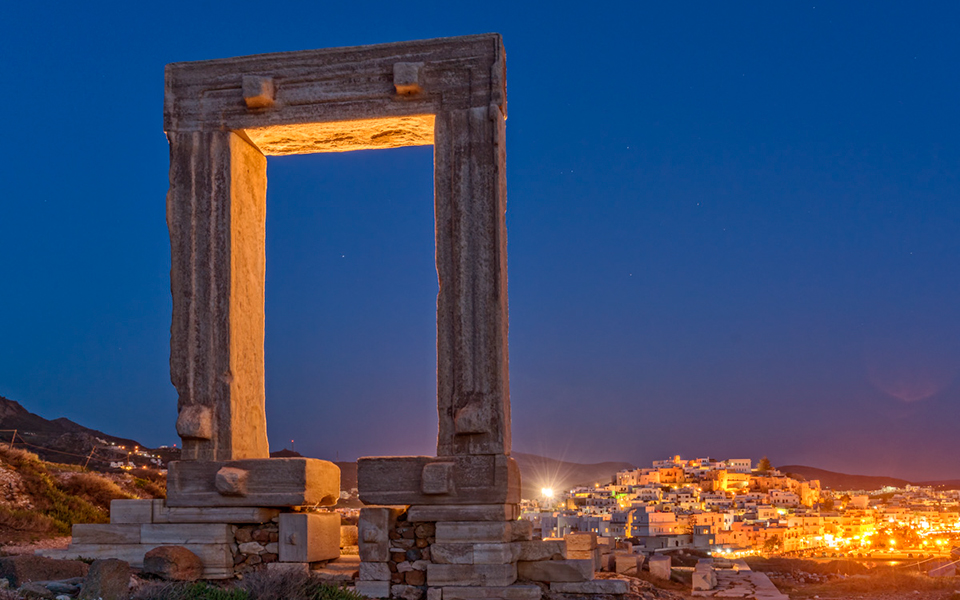
No matter what time of day you visit it, the huge marble gate of Portara on the islet of Palatia, close to the port, is always breathtaking.
© Perikles Merakos
A marble table with iron legs dominated the center of the courtyard, filled with bougainvillea, jasmine, lavender and other aromatic plants. It looked old.
The turquoise front door stood open, propped that way with a piece of local emery rock. Candles illuminated the whitewashed tiles.
After the day’s trip to windless Kalados Bay for a picnic and a dip – skinny, for some – we were as tired as could be. The soft sand on the island’s southernmost beach had felt wonderful on our feet, but the 20 kilometers of dirt road required to get there had exhausted us.
My friend’s wife offered us food and drinks: “I wasn’t expecting you to come. I’ll whip something up to go with the wine,” she said shyly, with the embarrassment of an eager hostess who isn’t certain she’ll be able to please her guests.
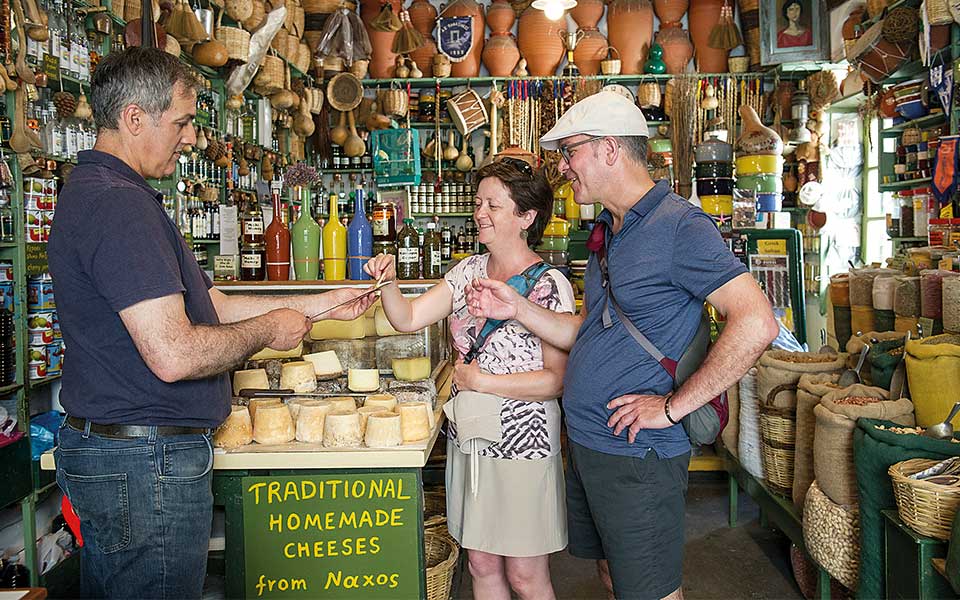
Tziblakis’ traditional grocery store in Naxos Town, with its abundance of local products, is a paradise for foodies.
© Vangelis Zavos
The “something” we were offered turned out to be an epic dinner.
First, two blue ceramic plates landed in front of us. One was filled with sweet tomatoes from Ano Potamia, seasoned with fragrant oregano from the holdings of the Chantziandreou family in the village of Sangri, a sprinkle of coarse salt, and a drizzle of Cycladic extra virgin olive oil from an olive grove in the Tragea region.
The other plate held finely chopped pieces of zamponi – a local charcuterie of cured pork leg – and nothing else, as it was meant to be eaten. This spicy native pork delicacy, which is similar to prosciutto, went well with the sharp notes in the wine from the vineyards of the Peristeraki brothers, who are helping to build on the island’s proud tradition of winemaking and raise its vinicultural image.
Their wines are natural, and possess strong flavors; they are produced in the village of Moni from mixed vineyards growing grape varieties largely unknown to the general public, like Avgoulato and Psoriatis.
Next on the table were fried PGI potatoes from Eggares with grated PDO Naxos graviera cheese, a platter of PDO Arseniko cheese, Thylikotiri cheese and an omelet made with fresh eggs and small pieces of local mutton.
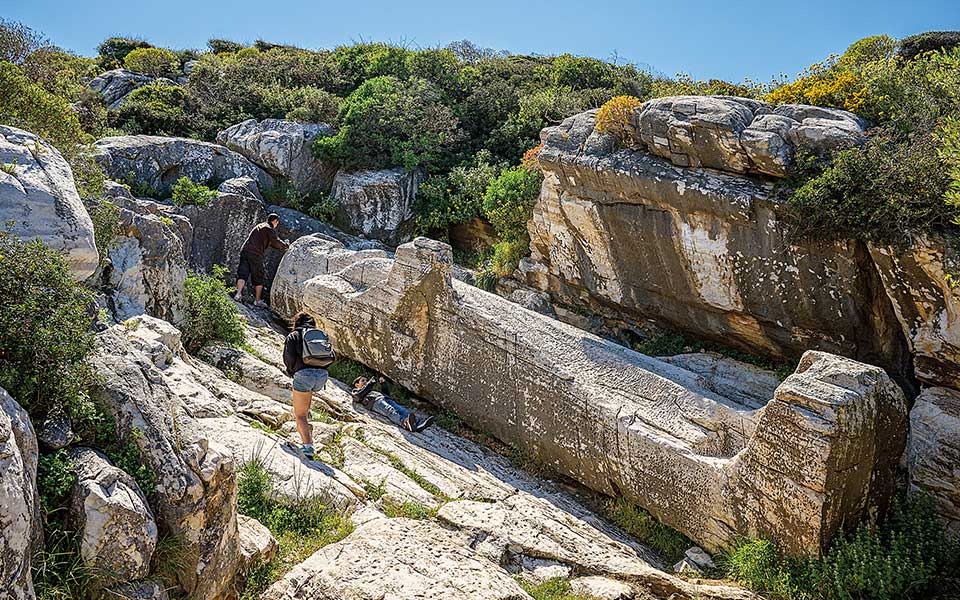
The Kouros statue outside the village of Apollonas is 11 meters in length.
© Perikles Merakos
By nightfall, nearly all the villages on Naxos had appeared on our table in edible form: each of our bites held the labor of these settlements’ hard-working residents. The delicious meat came from livestock bred on the slopes of Mt Za where, according to Greek mythology, Zeus, greatest of the twelve gods, was raised.
The cheese came from producers who compete against each other in the art they inherited from Aristaeus – the son of the sun god Apollo, who was a cheese-maker – and who spend countless hours tending cauldrons heated over fires. The fine zamponi, too, testified to the great passion and love with which it was produced.
The soul of Naxos lives in its cuisine, a rich treasure based on pure ingredients presented without undue fuss. This same straightforwardness is mirrored in the island’s people, who, even today, like to go about their daily business much as their ancestors did, using their hands to get things done. And indeed, it is with these hands that they play the tsambouna (Greek bagpipes) at festivals, it is with these hands that they harvest their grapes in honor of Dionysus, it is with these hands that they milk their animals and gather wild herbs in the mountains.
Naxos is a large island with great gastronomy, a rich cultural tradition, and a long history that stretches back into myth and legend. It is a harmonious combination of picturesque villages perched on hilltops and mountain slopes and inviting settlements built alongside beaches of golden sand, with charm enough to win the heart of any visitor.
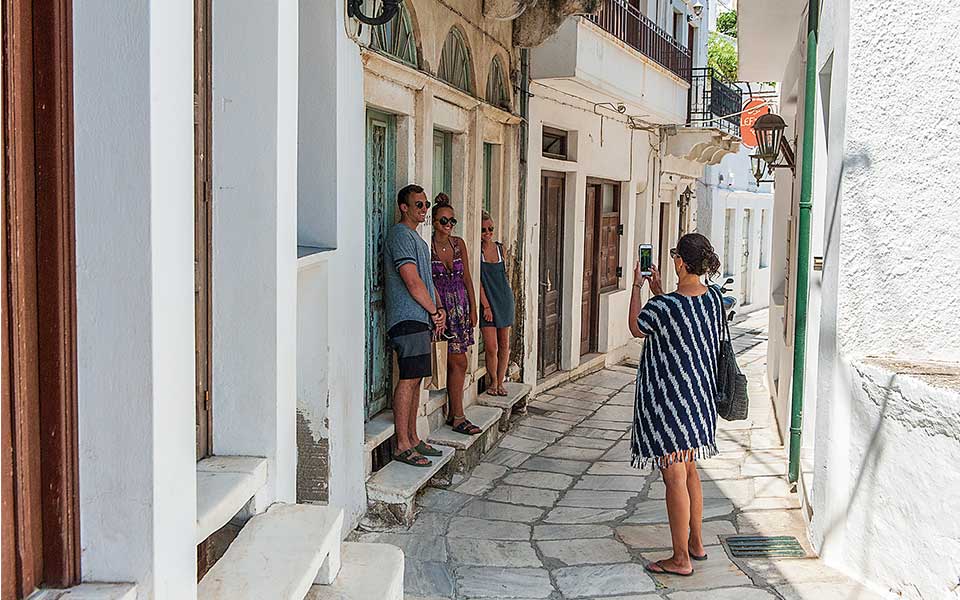
The village of Apeiranthos on Naxos
© Giorgos Detsis
Far inland from Portara, the huge marble gate of the Ancient Temple of Apollo which adorns the port of Hora, you’ll find inviting hilltop settlements and mountain villages that will tempt you to forego time at the beach in order to explore them.
The most famous of these is Apeiranthos, designated as a “traditional” settlement in 1978, which stands at the foot of Mt Fanari. With its own distinct dialect, narrow medieval arched alleyways, five museums, old windmills and impressive Byzantine and Venetian monuments, including the Zevgolis tower close to the village entrance, this village, the birthplace of the patriot Manolis Glezos, has more to offer than you can see in a day or two.
The Church of Aghia Kyriaki, with its abstract murals from the 8th-9th centuries, should not be missed, and you should also stop in to watch the women of the local cooperative weaving textiles on looms.
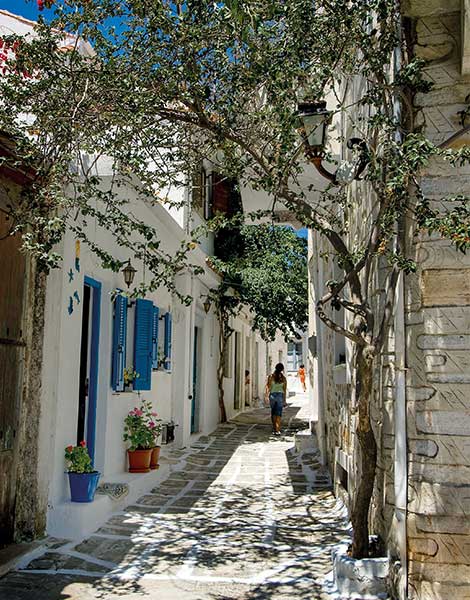
A picturesque alleyway in the village of Halki
© Clairy Moustafellou
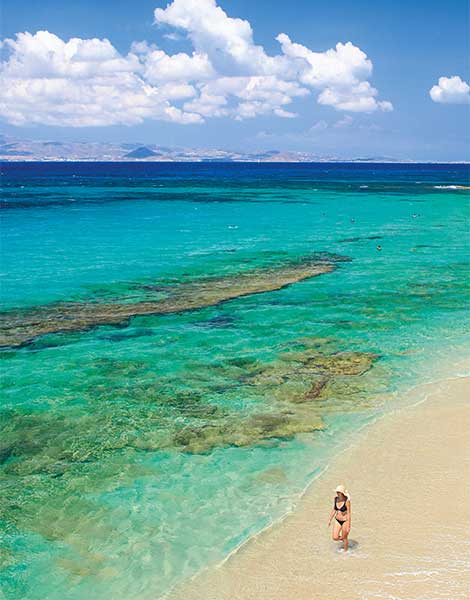
The green-blue waters of Plaka Beach
© Visual Hellas
A bit further south, you’ll find the farming village of Filoti, where over 100 family dairies ensure that this is where the largest quantity of sheep’s and goat’s milk is produced. The village spans two hills, forming a half-circle; its trademark is the age-old plane tree at the “Bridge” – the name of the central square. Should you sit down at a table there, you’ll likely only get up from it to dance: one of the groups there will eventually start singing kotsakia (improvised eight-syllable couplets) and, before you know it, you’ll be dancing ‘til dawn.
Another place that’s as impressive as Apeiranthos and Filoti is the tiny village of Halki, which is one of the island’s former centers of trade. The Vallindra Distillery, operating since 1896 and producing an aromatic PDO citrus liqueur, and the restored Barozzi Tower, are two of the village’s most interesting sights.
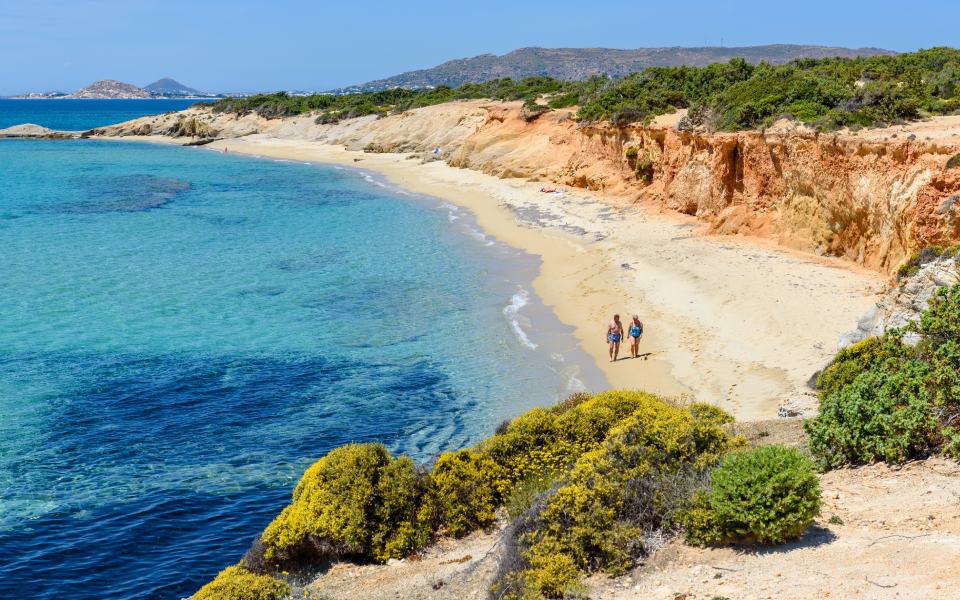
Alykos Beach
© Shutterstock
Aghios Prokopios, facing Paros on the island’s west coast, is by far one of the best Cycladic beaches, and the star of the island. Although it has become very touristic, with development taking place in the area surrounding it as well, you really should see its white sands and take at least one morning swim in its pristine blue waters.
The nearby golden beach of Aghia Anna is also mesmerizing; it is home to the island’s fishing fleet, and its dense tamarisk trees offer their shade to bathers.
Windless Alykos Beach, on the other hand, may attract fewer people, but its prickly cedar forest gives it a unique natural beauty. It’s an ideal spot for an afternoon nap or a splash around in its calm waters, which resemble those of a swimming pool.
If you’re a fan of windsurfing, you should head to Mikri Vigla or to Orkos. If you like exotic sandy beaches, try Panormos with its tall palm trees. Northeast from there is Lionas, a pebble beach that seems unpromising at first glance but which has an interesting seabed.
In fact, Naxos has so many beaches that, whenever I come here, I’m tempted to try a new one every day.
Nonetheless, I always make time for two non-swimming destinations that remain dear to me: the first one is in Halki, so I can gaze at Aghios Isidoros (Saint Isidore) as portrayed in the early Christian frescoes at the Church of Panaghia Protothronos, before enjoying a Greek coffee and some galaktoboureko at Galani’s café.
The second stop is at Taverna Axiotissa, near Kastraki, so I can have one of the house specialties: amazingly tender goat cooked in parchment paper.
From kafeneia serving souma and meze...
Igor Borisov turned Kimolos into his...
The signature dish of the island...
Discover Pyrgi in Chios, a medieval...